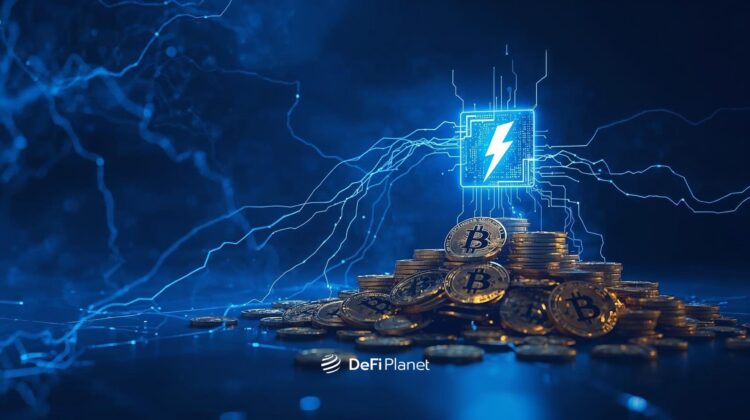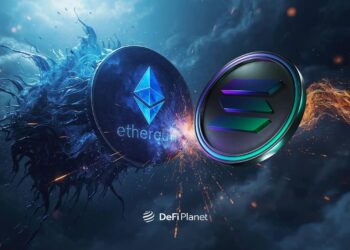In the digital asset world, passive crypto income has become a hot topic. While some people focus on trading or mining, others are looking for simpler, low-effort ways to grow their Bitcoin over time. For those people, running a Lightning node has emerged as a smart way to earn small amounts of Bitcoin while helping to strengthen the network.
The Lightning Network was created to solve one of Bitcoin’s biggest problems: speed. It allows users to send Bitcoin almost instantly and at lower fees by creating secure off-chain payment channels. This makes it easier for Bitcoin to function as an actual digital currency, especially for everyday transactions.
Whether you’re a crypto enthusiast or just want a new way to earn from Bitcoin without trading, this guide will walk you through what a Lightning node is, how it works, and how you can set one up to start earning passive crypto income. Let’s get started.
What Is the Bitcoin Lightning Network?
Bitcoin is known for being secure and decentralized, but it can also be slow and expensive when the network gets busy. A typical Bitcoin transaction on the mainnet can take several minutes, sometimes longer, and fees can spike depending on traffic. This makes Bitcoin less practical for small, everyday payments like buying coffee or splitting a bill.
The Lightning Network was created to fix that. It’s a second-layer solution built on top of the Bitcoin blockchain. Instead of recording every single payment on the main blockchain, Lightning uses payment channels to handle transactions off-chain, meaning they don’t need to be confirmed by miners every time.
So, how does Lightning Network work? Two people open a payment channel by making a regular Bitcoin transaction on the mainnet. Once that channel is open, they can send Bitcoin back and forth instantly, as many times as they want, without touching the main blockchain. Only when the channel is closed does the final balance get recorded on the mainnet. This approach reduces congestion and lowers fees.
What Is a Lightning Node and Why Run One?
A Lightning node is a computer that helps move Bitcoin payments through the Lightning Network. Think of it like a relay station: when two people aren’t directly connected, a node can step in to route the payment from sender to receiver through a chain of connections.
The main job of a Lightning node is to facilitate these payments by finding the fastest and most reliable route. Whenever your node helps process a transaction, you can earn a small fee in Bitcoin. It might not make you rich overnight, but over time, those micro-earnings can add up, especially if your node is well-connected.
So why bother running one?
- Support Bitcoin scalability: By keeping small transactions off the main blockchain, you help reduce congestion and lower network fees.
- Earn passive BTC: Every time your node successfully routes a transaction, you receive a tiny fee as a reward.
- Strengthen decentralization: More nodes mean a more resilient network, with fewer points of failure and more trust spread out among users.
Running a node gives you a hands-on way to contribute to the future of Bitcoin, while earning a little in return.
How You Earn: Fee Structures Explained
When you run a Lightning node, you earn money through routing fees. Every time your node helps send a Bitcoin payment from one user to another, it acts like a toll booth, collecting a small fee for the service. These fees are set by you and come in two parts: a base fee (a fixed amount per transaction) and a fee rate (a percentage of the payment amount).
But not all nodes earn the same.
To actually make money, your node needs good channel liquidity, meaning you have enough Bitcoin available in the right places to route transactions smoothly. And it needs to be online 24/7. If your node is offline or low on funds, it won’t be chosen to route payments, and you won’t earn anything.
So, what can you realistically expect?
If you’re a small, hobbyist operator, you might earn between $1 and $20 per month, depending on how active your channels are and how well your node is connected. That might not sound like much, but remember, this is passive crypto income you’re earning while supporting the Bitcoin network.
What You Need to Start a Lightning Node
Before you can start earning Bitcoin passively, you’ll need the right hardware, software, and a little bit of Bitcoin to get your Lightning node up and running.
Hardware options
There are different ways to set up a Lightning node, depending on your budget and technical comfort.
- Raspberry Pi setups (low-cost DIY):
Many beginners start with a Raspberry Pi, a small, affordable computer. It costs around $50–$150 all-in and uses little electricity. With some DIY effort, you can install everything yourself and run a full Bitcoin and Lightning node from home.
- Plug-and-play options (e.g., Umbrel, Start9, myNode):
If you prefer convenience, plug-and-play node products are available. These often include a Raspberry Pi preloaded with user-friendly software and interfaces. Just plug them in, follow a few setup steps, and you’re online.
- Cloud hosting vs. local hardware:
You can also host your Lightning node in the cloud using services like Voltage or AWS. This option avoids hardware maintenance but comes with monthly fees and removes some of the privacy benefits of running a node at home.
Software options
Your Lightning node needs software to manage payments and channels.
- LND vs. Core Lightning vs. Eclair:
These are the three main Lightning implementations.
LND is the most beginner-friendly and widely supported.
Core Lightning is more modular and powerful, but geared toward advanced users.
Eclair is popular for mobile and enterprise users.
- GUI tools for beginners (Ride the Lightning, Thunderhub):
Managing a node via command line can be intimidating, so graphical user interfaces (GUIs) like Ride the Lightning and Thunderhub make it much easier. They give you dashboards to open channels, check fees, and track earnings, all with clicks instead of code.
Bitcoin and Liquidity Requirements
Running a Lightning node isn’t free; you need to fund it with some Bitcoin.
- Need to fund your node with BTC:
Before your node can route payments, you must deposit Bitcoin into it. This BTC is used to open payment channels, which are the backbone of the Lightning Network.
- Opening and balancing channels:
To be useful to the network and to earn fees, you must open payment channels with other nodes. Ideally, you’ll open channels with nodes that are well-connected or often used. You also need to monitor and rebalance channels, making sure there’s Bitcoin on both sides to route payments efficiently.
Step-by-Step Setup Guide
Getting your Lightning node up and running is simple, even for non-coders. Here’s how to go from zero to routing Bitcoin transactions.

1. Choose your hardware and OS
Start by picking your hardware setup. You can go with:
- A Raspberry Pi if you want a low-cost, DIY experience.
- A plug-and-play device like Umbrel or Start9 for an easier route.
- A cloud-hosted server (e.g., Voltage) if you prefer not to deal with physical devices.
Once you’ve got your hardware, you’ll install an operating system. Popular choices include Umbrel OS, Raspberry Pi OS, or Linux-based systems, depending on your setup.
2. Install Bitcoin Core and sync to the blockchain
Before you can use the Lightning Network, your node must be part of the Bitcoin network. That means installing Bitcoin Core, the full Bitcoin client.
- It will begin syncing the entire blockchain, which can take several days and requires around 500 GB of storage.
- Let it complete this process; your Lightning software won’t work until the Bitcoin node is fully synced.
3. Install Lightning software
Once Bitcoin Core is synced, install your chosen Lightning implementation:
- LND is the most beginner-friendly.
- You can install it directly or use platforms like Umbrel or myNode, which come with LND pre-installed.
You’ll also want to install a GUI like Ride the Lightning or Thunderhub to make managing your node easier.
4. Fund your wallet with BTC
Your node will generate a Bitcoin address. Send some BTC to it. This will be the balance you use to open Lightning channels. Most beginners start with a small amount (e.g., $50–$200 worth of BTC).
5. Open channels with other nodes
With BTC in your wallet, you can now open payment channels with other nodes on the network.
- Choose reputable, well-connected nodes to improve your chances of routing traffic.
- Most interfaces let you pick from suggested peers, or you can enter a public node address manually.
The amount you allocate to each channel affects your ability to route payments; more liquidity often means better routing.
6. Start routing and monitoring activity
Once channels are open and balanced, your node can begin routing Lightning transactions between other users.
- You’ll earn small routing fees every time your node helps move Bitcoin from one user to another.
- Use dashboards like Thunderhub to track earnings, monitor uptime, and rebalance channels when needed.
Running a node isn’t set-and-forget. Occasional check-ins will help you keep it active, optimized, and earning.
Final Thoughts: Is Running a Lightning Node Worth It?
Running a Lightning node can be rewarding, but it’s not without its challenges. There’s always the risk of downtime, channel management mistakes, or even small losses if things go wrong. It’s not a completely hands-off system, as keeping your node online, secure, and balanced takes attention and some technical know-how.
That said, running a node is one of the most hands-on ways to support Bitcoin’s mission of decentralization. Instead of relying on large, centralized services, you’re helping process payments directly. For those who believe in the Bitcoin network’s values, it’s a meaningful contribution to its long-term resilience.
Earnings from routing fees are typically small at first, often just a few dollars a month, but it’s a great way to learn how the Lightning Network works. With time, experience, and more capital, you can grow your setup, improve your passive income effortlessly, and become a more active part of Bitcoin’s future infrastructure.
Disclaimer: This article is intended solely for informational purposes and should not be considered trading or investment advice. Nothing herein should be construed as financial, legal, or tax advice. Trading or investing in cryptocurrencies carries a considerable risk of financial loss. Always conduct due diligence.
If you would like to read more articles like this, visit DeFi Planet and follow us on Twitter, LinkedIn, Facebook, Instagram, and CoinMarketCap Community.
Take control of your crypto portfolio with MARKETS PRO, DeFi Planet’s suite of analytics tools.”





















